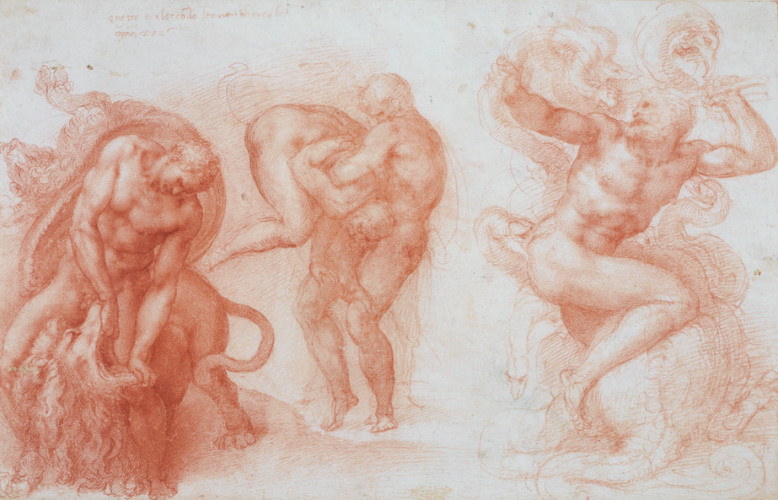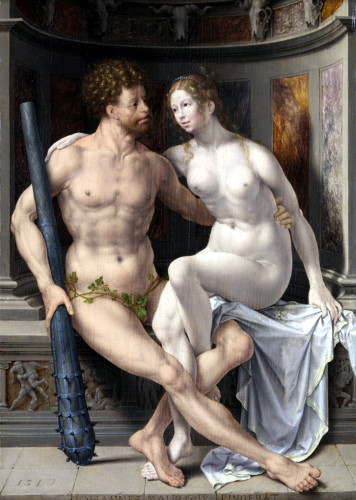I have not been this excited about a Getty exhibition since their once in a lifetime Boucher exhibit. Like that one, this is another once in a lifetime opportunity to see all these works in the same place without having to travel all over Europe. Jean Fouquet’s 1450s Virgin and Child (title pic above) may never travel again. It really is the cream of the crop of Renaissance nudes. The show runs through January 27th, and if you miss it you’ll have to travel to London’s Royal Academy where it begins in March. You really don’t want to miss it, though, as it is an absolutly spectacular collection.
I was intimately familiar with almost every work on display in the current Getty exhibit The Renaissance Nude. I have spent countless hours digitally removing cracks and blemishes from digital versions of almost everything on display in the show. That is because I have been working on nude and erotic art from artists who lived between 1440 and 1940. That does leave out a number of artists in this show who lived outside of that narrow 500 year window.
This was all for my new book, Passion: Artists and Their Nudes, available on Amazon in March 2019. You can read all about it and the associated digital art restoration project featuring over 30,000 works of art at the link.
The Renaissance was a good starting point as that was when the nude began to be more acceptable, at least as long as it was in the proper context. Body shame can be traced back to the story of Adam and Eve, although clearly the idea of the nude body being sinful had to be around before that to be incorporated into the story.
By 1530, the nude began to dominate in art, and Michelangelo’s nudes had found their way into the Sistine Chapel. Sure, fifty years after they were painted the Pope would order that clothing be painted on the nudes that was not removed until the 1990s, but they had a good run.

There are over 100 paintings, drawings, sculptures, illuminated manuscripts, and prints from Italy, France, Germany, and the Netherlands. They include Leonardo da Vinci, Raphael, Michelangelo, Hans Baldung (Grien), Dürer, Titian, Dosso Dossi Giorgione, Correggio, Messina and others, spanning from 1400 to 1530. This was a significant period in the development of the nude. The show is also divided evenly between male nudes and female nudes. This fairly reflects the times.

According to curator Jill Burke in a piece she wrote for the Guardian: “To take 15th-century Florence as an example, it’s been estimated that as many as 17,000 men were accused of sodomy from a total population of around 40-50,000—that’s the majority of Florentine men incriminated for same-sex relations. Not surprisingly, the erotic qualities of the naked male body were very much part of contemporary discourse, and it was assumed that women, as well as men, could be aroused by images of naked people of either sex.”
Two important changes came together during the Renaissance. Ancient art from antiquity had been rediscovered, and it included no shortage of nudity. This ancient art was considered elevated, so it helped make nudity more acceptable. At the same time, artists began to study art more scientifically, and realized that the basis of all figure drawing was a firm understanding of anatomy. This led to far more realistic nudes.

While nudes were arousing to people at the time, they had to be in an acceptable theme. Common stories were used that illiterate people could follow without reading any accompanying text, and if nudity made any sense within that theme, it would be generally acceptable. The themes that included nudity were typically ancient Roman and Greek mythology and stories from the Bible.
A painted nude of a known person would have been scandalous, but even so, powerful men and royalty liked to have paintings done of their mistresses, often with one breast bared. Fouquet’s Virgin and Child is the earliest known example. The model is believed to have been Agnes Sorel, the mistress of King Charles VII of France. It is part of a religious diptych. Dutch historian Johan Huizinga wrote of it: “There is a flavour of blasphemous boldness about the whole, unsurpassed by any artist of the Renaissance.”

The show is organized under several themes: The Nude and Christian Art; Humanism and the Expansion of Secular Themes, Artistic Theory and Practice, Beyond the Ideal Nude, and Personalizing the Nude. They also focus on a number of specific themes, such as Venus and Saint Sebastian.
If nude art is an interest, this is one of the more important art shows to see. Prints of paintings never do them justice. Seeing the actual paintings took my breath away.
If you can’t see the show, they still have a great companion book. It is titled The Renaissance Nude and was edited by Thomas Kren, Jill Burke, and Stephen J. Campbell. Published by the J. Paul Getty Museum, in includes more than 250 artworks by the greatest masters of the Renaissance in its 432 pages.
